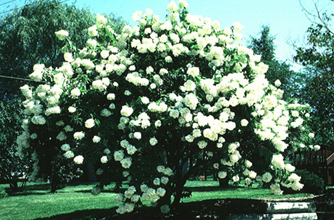What is elderberry rust?
Elderberry rust is a visually striking fungal disease that affects stems, leaves and flowers of plants in the genus Sambucus (i.e., elderberries). The disease also affects sedges (Carex spp.). On elderberries grown as ornamentals, as well as on sedges, the disease is primarily a cosmetic problem. However, if elderberries are grown for fruit, the disease can disrupt flower and fruit formation, thus reducing fruit yield.
What does elderberry rust look like?

Elderberry rust is most noticeable on elderberries where it causes growth distortions and swellings (i.e., galls) on leaves and stems. Galls are often very large, bright yellow and powdery from spores produced by the causal fungus. In extreme cases, galls can resemble banana slugs that have attached themselves to branches. Infected flowers become thick, swollen and green-tinged rather than white. Affected plant parts are covered with a network of small (approximately 1/16 inch in diameter) ring-like spots. These spots are reproductive structures of the rust fungus and produce the powdery spores that coat the galls.
On sedges, elderberry rust causes brownish leaf spots, often with yellow halos. The spots eventually erupt releasing powdery, rusty-orange spores.
Where does elderberry rust come from?
Elderberry rust is caused by the fungus Puccinia sambuci, also known as Puccinia bolleyana. The fungus overwinters in sedge debris, and spores produced in this debris blow to elderberry plants in the spring, leading to infection and gall formation. Spores produced in elderberry galls blow back to sedges, where infection of newly produced leaves (and other plant parts) occurs. These infections lead to spotting and to the formation of a third type of spore that reinfects sedges causing additional spotting. Late in the season a fourth type of spore is produced that serves as the overwintering phase of the fungus. Infection of both elderberries and sedges is favored by wet weather.
How do I save plants with elderberry rust?
Elderberry rust is not a lethal disease on either elderberry or sedge. When galls form on elderberry, simply prune these out. This will make elderberry plants more aesthetically pleasing and limit spread of the fungus to sedges. When pruning, cut branches four to six inches below each gall. Between cuts, decontaminate pruning tools by treating them for at least 30 seconds with 70% alcohol (e.g., rubbing alcohol straight out of the bottle), a spray disinfectant containing 60-70% active ingredient, or a 10% bleach solution (i.e., one part of a disinfecting bleach and nine parts water). If you decide to use bleach, be sure to rinse your tools thoroughly after you are done pruning and then oil them to prevent rusting, which can be caused by bleach use. Dispose of galls by burning (where allowed by local ordinance) or burying them.
How do I avoid problems with elderberry rust in the future?
In landscape settings, the best way to avoid problems with elderberry rust is to remove any sedges that are growing near elderberry plants. The farther the distance between elderberries and sedges, the less likely that elderberry rust will be an issue. Also, increase airflow around elderberry plants by thinning them and removing surrounding plants. Increased airflow will dry plants more rapidly and make the environment less favorable for infection. Do not use a sprinkler to water plants, as that wets leaves and provides a better environment for infections to occur. Instead, use a soaker or drip hose to apply supplemental water to the soil at the drip lines of the plants (i.e., the edges of where the branches extend). While fungicides are available for rust control in commercial elderberry production, these products are not recommended for use in home garden settings.
For more information on elderberry rust:
Contact the University of Wisconsin Plant Disease Diagnostics Clinic (PDDC) at (608) 262-2863 or pddc@wisc.edu.
Authors: Brian Hudelson UW-Madison Plant Pathology
Last Revised: 02/29/2024
D-number: D0049
References to pesticide products in this publication are for your convenience and are not an endorsement or criticism of one product over similar products. You are responsible for using pesticides according to the manufacturer’s current label directions. Follow directions exactly to protect the environment and people from pesticide exposure. Failure to do so violates the law.
Thanks to Katherine Amann, Kaitlyn Davis, and Ann Wied for reviewing this document.
A complete inventory of UW Plant Disease Facts is available at the University of Wisconsin-Madison Plant Disease Diagnostics Clinic website: https://pddc.wisc.edu.
Send a Plant Sample for Analysis
Be cautious when self-diagnosing plant health issues. Very few diseases can accurately be diagnosed by eye.
Contact the UW Plant Disease Diagnostics Clinic (PDDC), and for a small fee, clinic staff can examine a plant, determine the cause of the disease/disorder, and provide advice on how to control or prevent the issue.
Download Article





 Summer Flowering Trees, Shrubs and Vines
Summer Flowering Trees, Shrubs and Vines Deciduous Tree Leaf Disease Quick Reference
Deciduous Tree Leaf Disease Quick Reference Silver Leaf
Silver Leaf Red Star Rust
Red Star Rust


